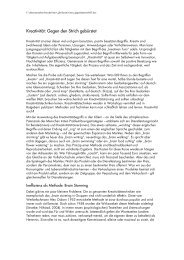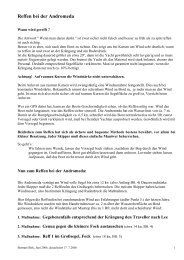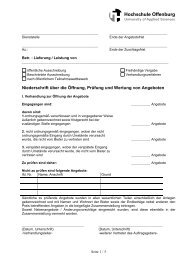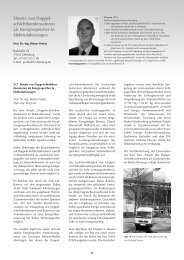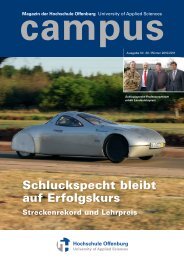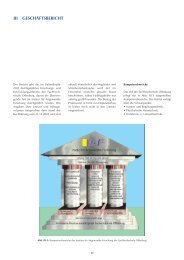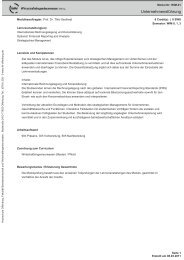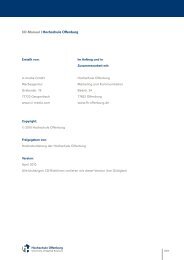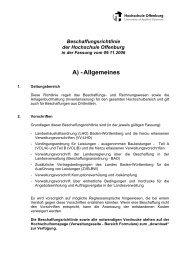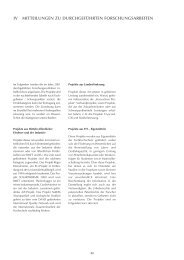FH Offenburg 2003/5 - an der Hochschule Offenburg
FH Offenburg 2003/5 - an der Hochschule Offenburg
FH Offenburg 2003/5 - an der Hochschule Offenburg
You also want an ePaper? Increase the reach of your titles
YUMPU automatically turns print PDFs into web optimized ePapers that Google loves.
The separation module, as it looks now,<br />
consists of three main parts:<br />
1. The centrifuge basket containing the<br />
ch<strong>an</strong>nel. The main task of the centrifuge<br />
basket is to prevent deformation<br />
<strong>an</strong>d leakage of the ch<strong>an</strong>nel.<br />
2. The rotating seals. These allow the<br />
carrier liquid to flow into the rotating<br />
ch<strong>an</strong>nel. The mech<strong>an</strong>ical stress of the<br />
seals c<strong>an</strong> be very high, as the pressure<br />
of the carrier liquid c<strong>an</strong> reach10 bar<br />
<strong>an</strong>d the rotary speed 10 m/s.<br />
3. The rotating system: a motor with its<br />
steering device <strong>an</strong>d the arbor of the<br />
machine.<br />
All FFF devices are composed of three<br />
main parts: <strong>an</strong> injection module consisting<br />
of a pump (like HPLC pump) <strong>an</strong>d <strong>an</strong><br />
injection valve, a separation module,<br />
<strong>an</strong>d a detector. The whole system c<strong>an</strong> be<br />
compared to a chromatographic device<br />
where the column is replaced by the FFF<br />
separation ch<strong>an</strong>nel. Figure V.15.6-1<br />
shows a separation system in FFF. The<br />
pump generates the flow of the carrier<br />
liquid in the system. Sample injection is<br />
carried out by <strong>an</strong> injection valve placed<br />
between the pump <strong>an</strong>d the ch<strong>an</strong>nel. At<br />
the ch<strong>an</strong>nel outlet the separated sample<br />
passes through a detector, usually a<br />
spectrometer, measuring the elution<br />
signals, called fractograms.<br />
Mainly, two different elution modes are<br />
observed: “Browni<strong>an</strong>” <strong>an</strong>d “Hyperlayer”;<br />
depending on: the intensity <strong>an</strong>d<br />
the nature of the external field; <strong>an</strong>d<br />
particle characteristics such as size,<br />
density <strong>an</strong>d shape. The elution or<strong>der</strong> of<br />
separated species depends on their<br />
average velocity (average position in the<br />
ch<strong>an</strong>nel thickness) <strong>an</strong>d was measured in<br />
terms of retention ratio R that is the ratio<br />
of the sample zonal velocity versus the<br />
mobile phase one.<br />
Sub-micron sized species elution mode<br />
is described as “Browni<strong>an</strong>”. Retention<br />
ratio depends on the particles external<br />
field susceptibility, their diffusion coefficient<br />
<strong>an</strong>d the external field strength. At<br />
the same density, particles least affected<br />
by the field <strong>an</strong>d/or having a high diffusion<br />
coefficient protrude into faster streamlines<br />
<strong>an</strong>d are eluted first. In the “Browni<strong>an</strong>”<br />
model, retention ratio is indirectly<br />
dependent on the external field strength<br />
<strong>an</strong>d independent on the flow-rate.<br />
Fig. V.15.6-1: Schematic description of <strong>an</strong> FFF system<br />
Figure V.15.6-2 illustrates the external<br />
field effect on the elution of 300 nm<br />
st<strong>an</strong>dard latex particles such as the<br />
effect of the relaxation time on the<br />
elution of a certain bacteria (i.e. the time<br />
for the particles to attend their diffusion<br />
equilibrium inside the ch<strong>an</strong>nel).<br />
67<br />
Micron-sized species elution mode is described<br />
as “Hyperlayer”. In this cases, R<br />
depends on the particle size, <strong>an</strong>d elution<br />
or<strong>der</strong> is reversed in comparison to the<br />
“Browni<strong>an</strong>” model. In “Hyperlayer” mode,<br />
also called “Focusing” mode, the flow velocity/ch<strong>an</strong>nel<br />
thickness bal<strong>an</strong>ce generates<br />
Fig. V.15.6-2: Fractograms showing respectively the relaxation time <strong>an</strong>d the external field effects<br />
eluted in the Browni<strong>an</strong> mode



